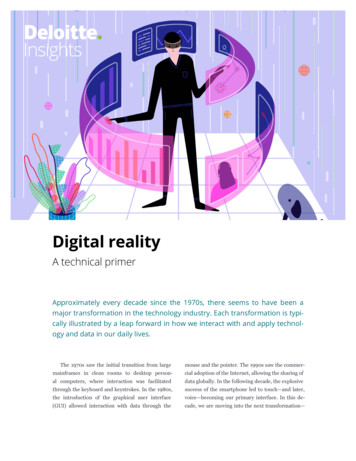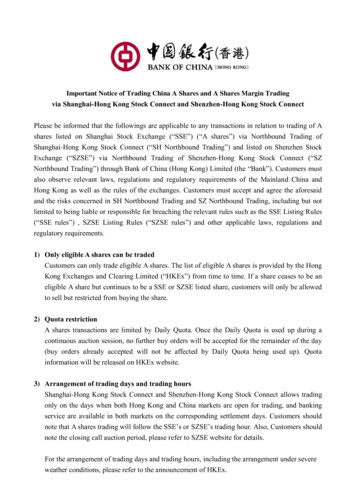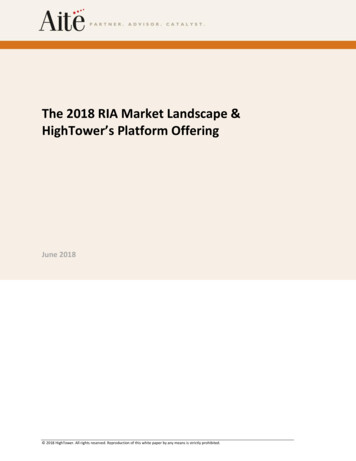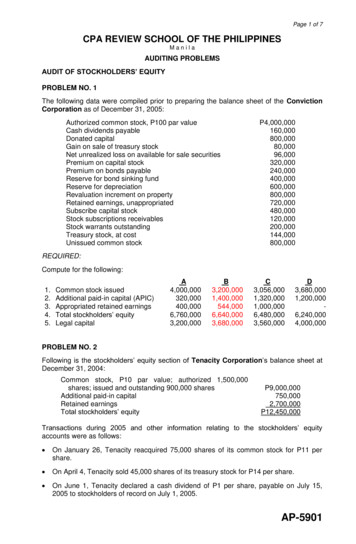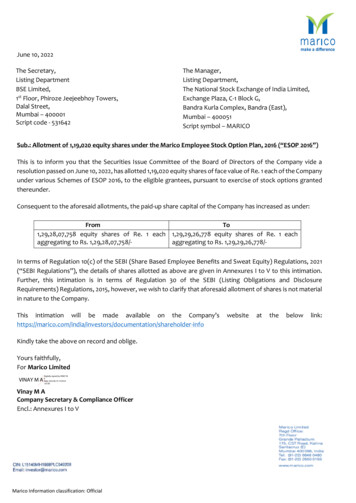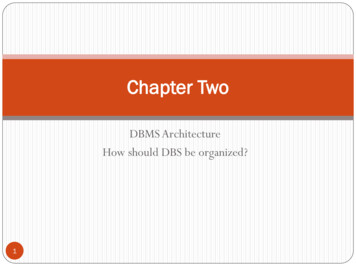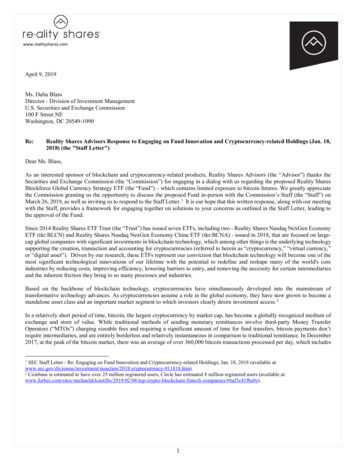
Transcription
www.realityshares.comApril 9, 2019Ms. Dalia BlassDirector - Division of Investment ManagementU.S. Securities and Exchange Commission100 F Street NEWashington, DC 20549-1090Re:Reality Shares Advisors Response to Engaging on Fund Innovation and Cryptocurrency-related Holdings (Jan. 18,2018) (the "Staff Letter")Dear Ms. Blass,As an interested sponsor of blockchain and cryptocurrency-related products, Reality Shares Advisors (the “Advisor”) thanks theSecurities and Exchange Commission (the “Commission”) for engaging in a dialog with us regarding the proposed Reality SharesBlockforce Global Currency Strategy ETF (the “Fund”) – which contains limited exposure to bitcoin futures. We greatly appreciatethe Commission granting us the opportunity to discuss the proposed Fund in-person with the Commission’s Staff (the “Staff”) onMarch 26, 2019, as well as inviting us to respond to the Staff Letter. 1 It is our hope that this written response, along with our meetingwith the Staff, provides a framework for engaging together on solutions to your concerns as outlined in the Staff Letter, leading tothe approval of the Fund.Since 2014 Reality Shares ETF Trust (the “Trust”) has issued seven ETFs, including two - Reality Shares Nasdaq NexGen EconomyETF (tkr:BLCN) and Reality Shares Nasdaq NexGen Economy China ETF (tkr:BCNA) - issued in 2018, that are focused on largecap global companies with significant investments in blockchain technology, which among other things is the underlying technologysupporting the creation, transaction and accounting for cryptocurrencies (referred to herein as “cryptocurrency,” “virtual currency,”or “digital asset”). Driven by our research, these ETFs represent our conviction that blockchain technology will become one of themost significant technological innovations of our lifetime with the potential to redefine and reshape many of the world's coreindustries by reducing costs, improving efficiency, lowering barriers to entry, and removing the necessity for certain intermediariesand the inherent friction they bring to so many processes and industries.Based on the backbone of blockchain technology, cryptocurrencies have simultaneously developed into the mainstream oftransformative technology advances. As cryptocurrencies assume a role in the global economy, they have now grown to become astandalone asset class and an important market segment to which investors clearly desire investment access. 2In a relatively short period of time, bitcoin, the largest cryptocurrency by market cap, has become a globally recognized medium ofexchange and store of value. While traditional methods of sending monetary remittances involve third-party Money TransferOperators (“MTOs”) charging sizeable fees and requiring a significant amount of time for fund transfers, bitcoin payments don’trequire intermediaries, and are entirely borderless and relatively instantaneous in comparison to traditional remittance. In December2017, at the peak of the bitcoin market, there was an average of over 360,000 bitcoin transactions processed per day, which includesSEC Staff Letter - Re: Engaging on Fund Innovation and Cryptocurrency-related Holdings, Jan. 18, 2018 (available cryptocurrency-011818.htm).2 Coinbase is estimated to have over 25 million registered users, Circle has estimated 8 million registered users (available 41f6a9c).11
www.realityshares.comthe highest daily volume of over 490,000 transactions processed on December 14, 2017. 3 Even following the bitcoin market declinesin 2018, bitcoin has shown tremendous resiliency averaging over 310,000 transactions per day in the first quarter of 2019. 4 Inaddition to the significant volume of daily remittance facilitated by the bitcoin network, it also provides significantly lowertransaction fees, averaging under 1.70 per transaction. 5 In comparison, the World Bank calculated the global average cost for a 200 MTO transaction in 2018 was 7.1%, or approximately 14. 6 Along with significantly reducing transaction costs, the peer-topeer functionality of a bitcoin transaction also removes a significant amount of friction from the remittance process, therefore makingbitcoin a cheaper and more effective option for electronic monetary transactions, especially amongst those in developing marketswith no, or limited access to, banking facilities, or distrust of traditional remittance intermediaries.We now make the argument that such recognition and placement within the global economic community now places bitcoin withinthe status of a global currency. Accordingly, we designed and filed the Fund as a first-time opportunity for investors to gain exposureto a basket of “Significant Global Currencies” (as that term is defined in the N-1A registration filing), including both fiat andcryptocurrency widely adopted for use throughout the world (e.g., as store-of-value, medium of international remittance, foreignexchange, tradable commodity) in a single, regulated, exchange-traded investment fund. 7The Staff Letter highlights the vitality of the U.S. investment fund market, predicated on responsible innovation and continuousimprovement in offered products to America’s main street investors. You specifically raise concerns regarding an investment fund’sability to satisfy the requirements of the Investment Company Act of 1940, as amended, (the "40 Act") when “holding substantialamounts of cryptocurrencies and [cryptocurrency] related products.” While we agree that several of these concerns may still beapplicable to the wider cryptocurrency ecosystem, we believe the growing maturity of bitcoin, and bitcoin futures specifically, havenow increasingly addressed and satisfied many of those concerns - allowing the Commission to support the issuance of a ‘40 ActETF holding U.S. exchange-traded futures contracts based on the value of bitcoin, with rules ensuring such bitcoin exposure as apercent of the fund’s total notional value does not grow to represent a “substantial” interest. To enact the Advisor’s global currencystrategy, the Trust filed the Fund for registration on February 11, 2019, on the basis of a limited exposure to bitcoin (non-substantialinterest), through the use of regulated exchange-traded bitcoin futures. The Advisor withdrew the filing per the Staff’s request onFebruary 12, 2019.At this point in time, we believe there is seemingly very little, if any, difference between a ‘40 Act fund holding bitcoin futures anda fund holding other commodity-linked derivative contracts. In 2015, bitcoin was established as a commodity under the CommoditiesExchange Act (“CEA”), and is therefore regulated by the Commodity Futures Trading Commission (“CFTC”) for anti-fraud andanti-manipulation purposes. 8 With bitcoin’s classification as a commodity established, and the listing of bitcoin futures on theChicago Mercantile Exchange (“CME”), along with other anticipated bitcoin futures contracts in development, 9 the CFTC has clearAvailable at: www.blockchain.com/charts/n-transactionsAvailable at: www.blockchain.com/charts/n-transactions5 Available at: www.bitcoinfees.info6 World Bank Migration and Development Brief 29 - Migration and Remittances: Recent Developments and Announcements, April 2018(available at: nt-brief-29).7 N-1A is available at: 19005966/tv512882 485apos.htm (Feb. 12, 2019).8 See CFTC v. McDonnell, 287 F.Supp.3d 213, 228 (E.D.N.Y. 2018) (“Virtual currencies can be regulated by the CFTC as a commodity.”); In reBFXNA Inc., CFTC Docket 16-19, at 5-6 (June 2, 2016) (“[V]irtual currencies are encompassed in the [CEA] definition and properly defined ascommodities.”); In re Coinflip, Inc., CFTC Docket No. 15-29, at 3 (Sept. 17, 2015); see also 7 U.S.C. § 1a(9).9 Intercontinential Exchange’s Bakkt platform plans to offer 1-day physically settled bitcoin futures contract (available gories/2018/08-03-2018-133022149); ErisX exchange and clearing platform plans to offer digitalasset futures contracts (available at: 342
www.realityshares.comjurisdiction over both the derivatives and spot markets for bitcoin, and potentially other virtual currencies. 10 However, for purposesof our responses below we will focus solely on bitcoin, and not any other virtual currencies.With bitcoin’s classification as a commodity under the CFTC’s jurisdiction established, it is unclear how allowing inclusion ofexchange-traded bitcoin futures in a ‘40 Act fund would increase investor risk any more than current ‘40 Act funds that hold othercommodity linked derivatives such as interest rate futures, oil futures, natural gas futures, FOREX futures, etc. 11 While it would befoolish to claim there are no bad actors attempting to manipulate the bitcoin market, it would be equally incorrect to claim there areno bad actors attempting to manipulate other commodity markets as well. We can point to a number of instances over the past decadewhere the spot and derivatives markets for other well-established commodities have been manipulated, in some cases over significantperiods of time. 12 We believe investors should not be denied exposure to this new asset class as the Fund - with its’ investmentlimitation rules on the position size of bitcoin futures - may potentially carry less volatility and liquidity risks than certain other ETFscurrently listed on U.S. exchanges that hold more substantial amounts of less liquid (or illiquid) commodity-linked derivatives, fixedincome and/or micro-cap securities, or those utilizing increased leverage.The Staff Letter also raises a number of concerns pertaining to cryptocurrency and cryptocurrency-related registered funds includingvaluation, liquidity, custody, arbitrage, and potential manipulation and other risks. In our responses below we offer our research,experiences and current operational control processes addressing each of these general concerns. We respectfully believe most ofthe stated concerns are mitigated through the design of the Fund, including: Approximately 85% of the Fund’s notional value is invested in short duration sovereign bonds and/or cash-equivalents,with the remaining 15% notional exposure to bitcoin provided through bitcoin futures, fully collateralized by treasury billsor cash-equivalents;A rules-based, limited, “non-substantial” exposure to bitcoin gained through U.S. exchange-traded bitcoin futures contractsthat are subject to regulatory oversight; andAn actively-managed Fund strategy providing daily professional portfolio management focused on risk mitigation, positionlimits, exposure limits, volatility, duration, etc.The Fund was designed with the retail investor in mind. It is constructed and registered under the ’40 Act, which offers greaterprotections to investors and provides the Commission more say in the final design of the product, along with greater transparencyinto its ongoing operations and investment through reporting, regular registration updates, and exams.We respectfully believe the Fund – with the inclusion of U.S. exchange-traded bitcoin futures contracts representing (i) a “nonsubstantial” component within the Fund, (ii) with no physical settlement so as to alleviate physical custody concerns while also10 7 U.S.C. § 9 (banning the use of any “manipulative or deceptive device or contrivance” in connection with the sale of a commodity); see alsoCFTC v. My Big Coin Pay, Inc., No. CV 18-10077-RWZ (D. Mass. Sept. 26, 2018) (“[T]he appropriate inquiry under the CEA is whethercontracts for future delivery of virtual currencies are dealt in, not whether a particular type of virtual currency underlies a futures contract.”).11 See Cboe Global Markets, Inc. Letter to Dalia Blass (Mar. 23, 2018), available at: �Although the CFTC only regulates the bitcoin spot market with respect to fraud and manipulation – in the same way that it regulates the spotmarket for gold, silver or other exempt commodities – it has full authority to oversee and enforce the Commodity Exchange Act as it applies totrading in bitcoin derivatives.”).12 See CFTC v. Amaranth Advisors, LLC, et al., 07-cv-6682 (S.D.N.Y. 2007); see also CFTC Press Release 5692-09, August 12, 2009 (availableat: www.cftc.gov/PressRoom/PressReleases/pr5692-09) (Amaranth Advisors, LLC, and Amaranth Advisors (Calgary) ULC, entered into aconsent order settling charges for attempting to manipulate the price of natural gas futures contracts traded on the New York MercantileExchange (NYMEX) on February 24, and April 26, 2006); CFTC Press Release 7000-14, September 15, 2014 (available at:www.cftc.gov/PressRoom/PressReleases/pr7000-14) (Brian Hunter entered into a consent order settling charges for attempting to manipulate theprice of natural gas futures contracts traded on the NYMEX on February 24, and April 26, 2006).3
www.realityshares.comallowing a greater number of Authorized Participants (“AP’s”) to participate in the arbitrage process, and (iii) CFTC anti-fraud andanti-manipulation oversight; combined with highly liquid sovereign bonds; and operating under the rules of a ‘40 Act registeredinvestment fund – addresses Chairman Clayton’s concerns, as he recently remarked on the viability of a bitcoin ETF, so long as “itcan be reasonably demonstrated that the underlying trading is generally not manipulated, it’s happening on reliable venues, withgood rules, and that custody is something we can feel comfortable about.” 13We also believe a ‘40 Act regulated ETF, with exposure to bitcoin through regulated exchange-listed futures, if made available toinstitutional and retail investors, would mitigate the necessity for such investors to seek the same investment exposure by transactingon unregulated or lightly-regulated exchanges - often domiciled outside of the United States. 14 We believe the established regulationand governance afforded by a ‘40 Act ETF structure for a cryptocurrency-related investment product within the United States offersthe investor protections and regulatory oversight investors and their professional advisers seek in order to satisfy demand forexposure to this new asset class, through this conservative investment strategy.ValuationHow would a fund develop and implement policies and procedures to value cryptocurrency-related products? How woulddifferences among various types of cryptocurrencies impact a fund’s valuation and accounting policies?The only cryptocurrency-related product the Fund will hold is U.S. listed exchange-traded bitcoin futures contracts. The Fund willnot invest directly in bitcoin, and has a transparent, rules-based approach to valuing bitcoin futures. The Fund’s policies andprocedures for valuing such bitcoin instruments follow the well-established practice of using the CME Exchange closing settlementprice of the underlying portfolio futures contracts for net asset value (“NAV”) calculation purposes – similar to all other fundsutilizing exchange-traded futures contracts.As regulated instruments, bitcoin futures contracts provide real-time reference prices and bid/ask quotes from/to the market(s)representing the price of physical bitcoin. Additionally, bitcoin futures contracts traded on the CME have closely followed bitcoinspot price. The CME supports the CF Bitcoin Real-Time Index (“BRTI”), a standardized reference rate which is effectively anaggregation of order books at cryptocurrency spot exchanges in the BTC:USD pair, producing a live streaming price index used asan indication of the spot market price, updating every second, every day. Since the launch of the futures contracts in December 2017,the average daily price difference between the CME bitcoin futures and the Coinbase bitcoin spot price has been 0.03%. 15With the Advisor’s established valuation and accounting policies for holding commodity futures, including U.S. listed exchangetraded bitcoin futures, and by limiting its bitcoin exposure to listed bitcoin futures, the Fund provides investors with limited exposureto bitcoin without the inherent risks that come with purchase/sale, settlement, transfer, custody and safekeeping physical bitcoin.How would a fund develop and implement policies and procedures to “fair value,” cryptocurrency-related products?The ‘40 Act requires underlying fund portfolio securities and other instruments for which market quotations are readily available tobe valued at current market values; and as prescribed by Section 2(a)(41), where current market quotations are not readily available,Available at: ce.Most cryptocurrency exchanges are regulated under state and federal money transmitter/money services business laws. While those laws doprovide certain consumer protections, they are not designed to provide the same level of investor and market protections as the federal securitieslaws.15 Bitcoin futures data and Coinbase bitcoin pricing data sourced from Bloomberg for the period 12/11/2017 to 02/08/2019. Figure represents alloutstanding and expired contracts on the CME (BTCH8 through BTCM9).13144
www.realityshares.comto be fair valued in accordance with policies and procedures as established and determined in good faith, and overseen by the Boardof Trustees of the sponsoring ETF Trust.Should closing prices for bitcoin futures not be available or not indicative of current market valuations for any reason, the Advisor’sPricing Committee would assist the Trust’s Board of Trustees in fair valuing the bitcoin futures pursuant to the Advisor’s existingfair valuation policies and procedures that includes, but is not limited to, using: (i) quoted prices from market dealers and exchanges;(ii) observable market inputs for price modeling; (iii) pricing vendors; and/or (iv) traded prices of comparable instruments. In theextraordinarily unlikely event that closing futures settlement prices are not available, the Advisor’s pricing procedures allow for fairvaluing the bitcoin futures based on all available pricing inputs, which may include prices from select spot exchanges. 16 We believehaving access to multiple exchange prices provides sufficient back-up pricing data to adequately price the Fund’s bitcoin exposureaccording to its pricing policies and procedures.How would a fund’s accounting and valuation policies address the information related to significant events relevant tocryptocurrencies? For example, how would it address when the blockchain for a cryptocurrency diverges into different paths(i.e., a “fork”), which could result in different cryptocurrencies with potentially different prices?The Fund’s accounting and valuation policies do not include specific provisions for significant events relevant to physicalcryptocurrencies as the Fund does not invest in physical bitcoin. The Fund only gains exposure to cryptocurrencies through U.S.exchange-traded futures contracts whereby provisions relating to significant events relevant to the underlying asset (i.e., a “fork”)and therefore the effect on bitcoin futures contracts are fully documented within the CME Exchange policies and procedures rules.Under the current CME Rulebook regarding a hard fork, CME bitcoin futures would continue to settle to the BRR (defined below)in its current form. 17 The BRR would not therefore become a sum of forked tokens, tracking only the current iteration of bitcoin.While the Fund’s accounting and valuation policies do not include specific provisions for significant events relevant to physicalcryptocurrencies, the fund’s accounting and valuation policies do outline a process for determining that the exchange settlementprice for bitcoin futures is reasonable and reliable in such instances.How would a fund identify, and determine eligibility and acceptability for, newly created cryptocurrencies offered bypromoters (e.g., an “air drop”)? How might a fund account for those holdings if the fund chooses to claim suchcryptocurrencies?The Fund will not invest in newly created cryptocurrencies offered by promoters (e.g. an “air drop”) and would disclose such fact inthe Fund’s prospectus. The Fund gains exposure to Bitcoin through U.S. exchange-traded futures contracts only.How would a fund consider the impact of market information and any potential manipulation in the underlyingcryptocurrency markets on the determination of the settlement price of cryptocurrency futures?While the impact of market information and potential manipulation in underlying markets is an important consideration, the issue isapplicable to all funds that hold asset-linked derivatives, not just those holding bitcoin futures. The U.S. market currently hasnumerous listed ETFs that hold futures contracts based on the value of commodities such as oil, natural gas, precious metals, interest16 See Bitwise Asset Management: Analysis of Real Bitcoin-Trade Volume, March 19, 2019 (available Trade-Volume.pdf) (Bitwise analysisidentified 10 spot exchanges with conclusively legitimate bitcoin trade volume – Binance, Bitfinex, Kraken, Bitstamp, Coinbase, bitFlyer,Gemini, itBit, Bittrex and Poloniex).17 See CME Rulebook, Rule 35005 - Policy on Divisions of Bitcoin Asset (available ulebook/CME/IV/350/350.pdf).5
www.realityshares.comrates, etc., as a portion of, or in many cases as the fund’s single investment strategy. Those commodities have all been subject to spotmarket misinformation and (attempted) manipulation in the past decade, however, the funds holding them have not been subjectedto increased scrutiny in regard to its effect on the settlement price of the corresponding futures. 18 Given the current depth of thebitcoin market in terms of the number of price-quoting market makers, participating exchanges, and developing institutional interest,we believe there is ample market participation to validate and disseminate the flow of information to maintain an orderly futuresmarket.With regards to the impact of potential manipulation in underlying bitcoin spot markets on the determination of the settlement priceof CME bitcoin futures, we believe the CME’s process for determining the expiry cash settlement prices of CME bitcoin futuressufficiently guards against potential manipulation affecting the futures’ settlement price. CME bitcoin futures are priced off the CMECF Bitcoin Reference Rate (“BRR”), which is the aggregation of executed trade flows from four (bitcoin) spot exchanges into a oncea day (4pm London time close) reference rate of bitcoin to USD, administered by Crypto Facilities. 19 The spot exchanges include:Kraken, itBit, Coinbase and Bitstamp; 20 which, as a recent independent study concluded, are four of the ten bitcoin spot exchangeswith actual, non-inflated bitcoin trading volume - and together represent a significant portion of actual bitcoin spot market tradingvolume. 21To establish the BRR standard settlement price, the CME bitcoin futures contract settles to a multiple volume weighted averageprice, calculated in five-minute increments over the course of one hour (3:00pm to 4:00pm GMT), across these multiple exchanges.Given such a broad settlement pricing process, any attempt at manipulation would certainly not go un-noticed by market participants.The use of a volume-weighted median price (meaning the equally-weighted average of the volume-weighted median) means anymanipulation attempt would need to manipulate the bitcoin spot market across four exchanges (each registered as a Money ServicesBusiness with FinCEN, among other regulatory designations), in each of twelve (5 minute) windows, to have any influence on theFund NAV at contract settlement. The BRR was designed around the best practices for financial benchmarks, and is fully transparentin terms of methodology. An expert CME oversight committee is responsible for overseeing the scope of the reference rates bydeveloping a code of conduct for the participants and regularly reviews the practice, standards and definition of the BRR to ensureit remains relevant and retains its integrity. 22If the situation developed however, whereby bitcoin futures held by the Fund were temporarily not indicative of current marketvaluations for any reason, such instruments would then be valued according to the fair value procedures explained above. Given theFund is constructed to have (i) a limited overall exposure to bitcoin (15%) versus other securities and cash (85%); (ii) is activelymanaged; and (iii) will only invest in exchange-listed bitcoin futures affording the types of regulatory and process controls outlinedhere, the impact of market information and any potential manipulation in the underlying cryptocurrency markets on the determinationof the settlement price of bitcoin futures is fairly limited - in our opinion.See CFTC v. Parnon Energy Inc., et al., cv-03543 (S.D.N.Y. 2014) (charging the attempted manipulation of the NYMEX Light Sweet CrudeOil futures contract spreads from January 2008 to April 2008 by amassing a dominant and controlling positions (“cornering”) in the physicalWTI crude oil market).19 Available at: cryptocurrency-reference-rate-methodology.html20 Available at: hanges-list.html.21 See Bitwise Asset Management: Analysis of Real Bitcoin-Trade Volume, 50-59 (Bitwise concluded that the notional value of actual bitcoinspot market average daily trading volume was 273 million versus the “reported” average daily volume of 6 billion, over the period March 4 - 8,2019. According to Bitwise, all ten of the “actual volume” exchanges had extremely tight bitcoin prices over the period January 1, 2018 to March17, 2019, with the four exchanges that comprise the BRR all having an average price deviation under 0.20% from the ten exchanges aggregatebitcoin price over the same period.); Bitcoin trading volume on Kraken, itBit, Coinbase and Bitstamp represents monthly average volume of86,330,046 BTC over the period December 17, 2017 through March 31, 2019 (sourced from Bloomberg).22 CME removed Bitfinex and OkCoin exchanges in April 2017 after banks blocked their customers from wiring USD in or out.186
www.realityshares.comLiquidityWhat steps would a fund investing in cryptocurrencies or cryptocurrency-related products take to assure that it would havesufficiently liquid assets to meet redemptions daily?The Fund will not invest directly in bitcoin. The Fund’s portfolio is comprised of (75%) highly-liquid sovereign bonds, (10%) othercash and cash-equivalent instruments, and no more than 15% of the Fund’s notional assets in bitcoin futures at any point in time (asrebalanced when threshold bands are met). Therefore, the steps taken to assure the Fund will have sufficient liquid assets to meetdaily redemption requests at all times includes: (i) a 15% limited exposure to bitcoin futures, fully collateralized by treasury securitiesor other cash-equivalents; (ii) bitcoin futures that are marked-to-market daily with the Futures Commission Merchant (“FCM”),limiting outstanding net exposure to one-day price movements; and (iii) the Fund’s maintenance 10% of its assets in cash and cashequivalents at all times/under normal circumstances.Since bitcoin futures first launched on December 11, 2017, the combined average daily notional value traded on the CME and CBOEexchanges was approximately 155.5 million, through February 8, 2019, which represented approximately 0.13% of the averagemarket capitalization of bitcoin over the same time frame. 23 With the final expiration of Cboe bitcoin futures expected in June 2019,CME bitcoin futures contracts are expected to absorb and expand listed volume. For Q1 2019, CME bitcoin futures average dailyvolume (“ADV”) as reported by the CME is up approximately 15% versus Q4 2018. This 15% represents approximately (in roundnumbers) 4,784 contracts, 90 million in notional value traded, and 24,000 bitcoin at an average spot price of 3,750 per bitcoin. 24While this represents average daily volume for the time period, market activity was as high as 18,338 contracts on February 19,2019, almost 4-times the prior period ADV. 25For conservative illustration purposes when looking at the potential scalability of the Fund, we do so here just in relation to CMEfutures volume, and not the potential scalability of the Fund in relation to the overall liquidity of the bitcoin spot markets which issubstantially greater.For this purpose, if we round current CME bitcoin futures ADV to 100 million notional, and assume the Fund held 100% of theADV, given the Fund’s 15% allocated notional position to bitcoin futures, this would translate to the Fund scaling to approximately 667 million in assets under management (“AUM”) based on the current futures ADV. To provide context, as of February 8, 2019,Invesco’s DB Gold Fund ETF (tkr:DGL) (“DGL”), which is composed of futures contracts on gold, had a market capitalization of 145.6 million and owned 1,078 CME Feb 2020 Gold Futures contracts. 26 The notional value of the gold futures contracts held byDGL is approximately 12.6 times the average daily trading volume of the contracts. 27 This further illustrates the potential scalabilityof the Fund based on the size of the futures market that may not be readily apparent when looking at average daily trading volumes.Even based on a conservative assumption (when compared to DGL) that the Fund would have sufficient liquidity if holding fivetimes the 90 million average daily notional value of
Since 2014 Reality Shares ETF Trust (the "Trust") has issued seven ETFs , including two - Reality Shares Nasdaq NexGen Economy ETF (tkr:BLCN) and Reality Shares Nasdaq NexGen Economy China ETF (tkr:BCNA) issued in 2018- ,that are focused on large- . Exchange Act ("CEA"), and is therefore regulated by the Commodity Futures Trading .
